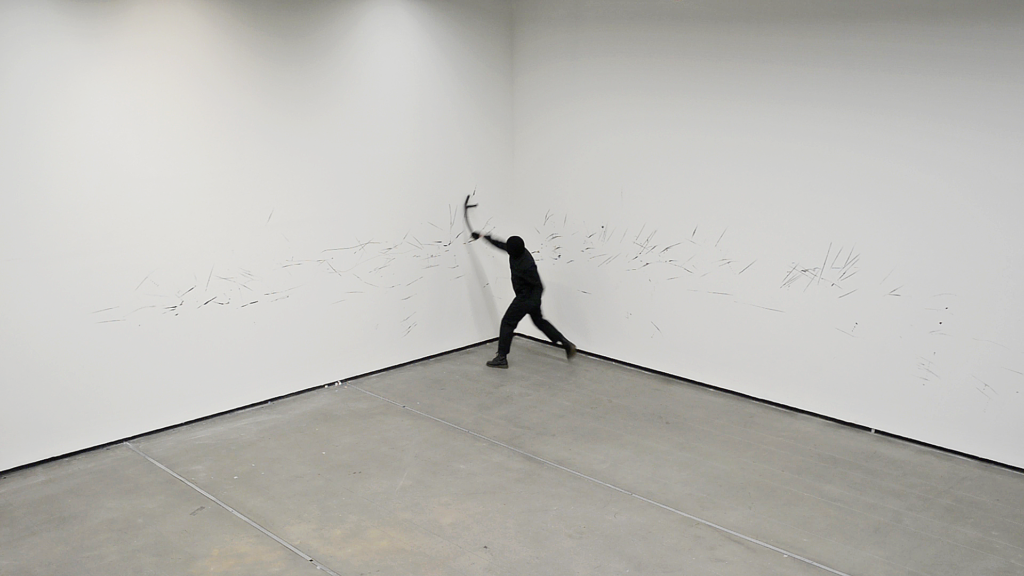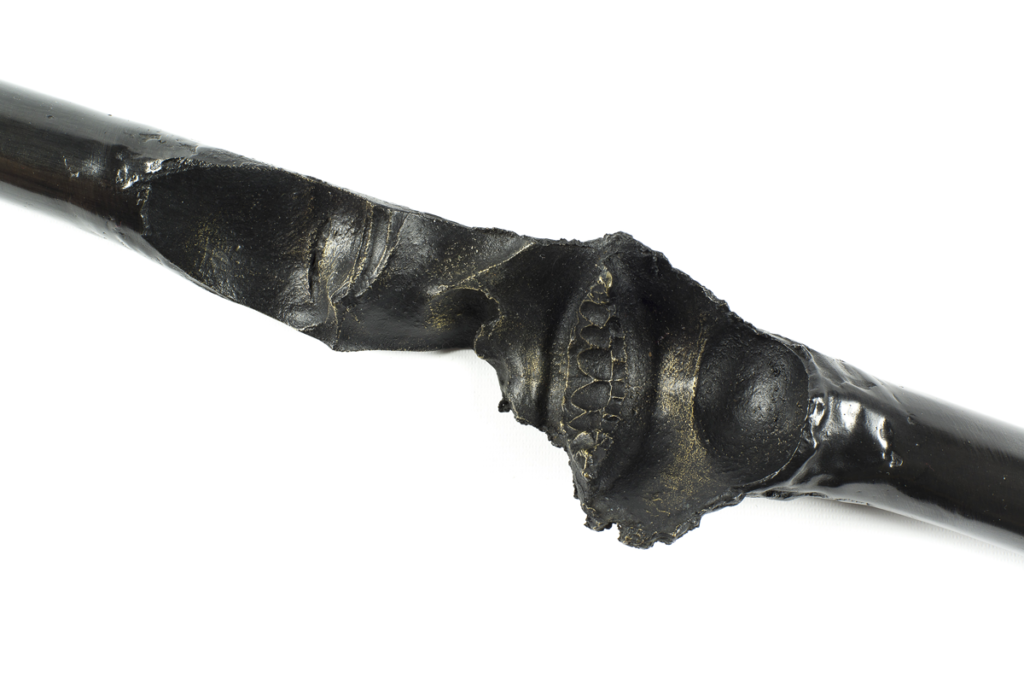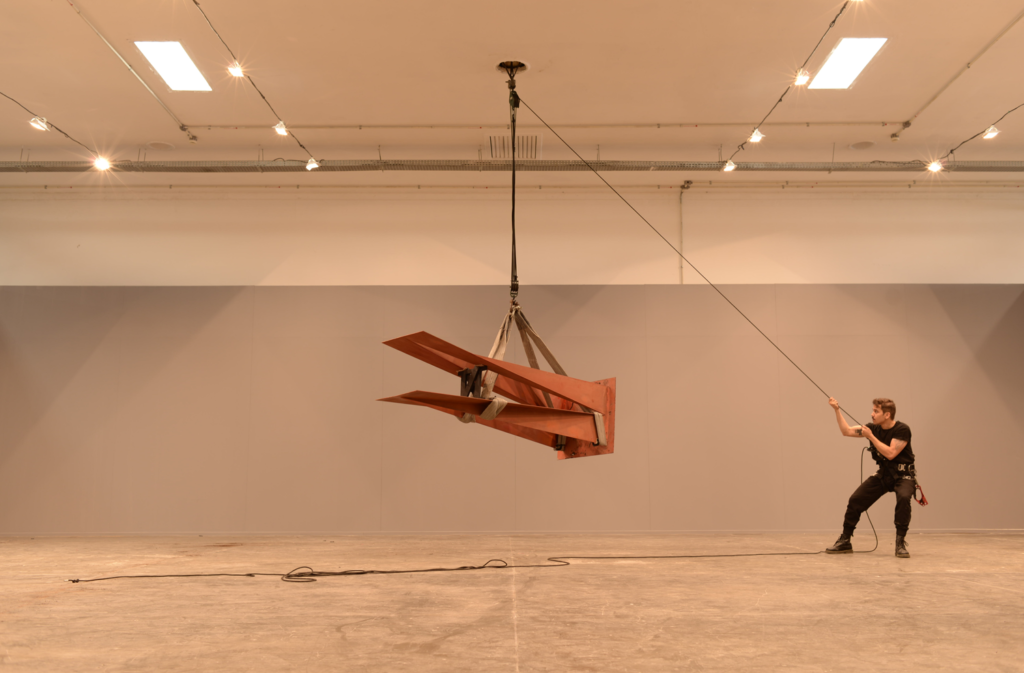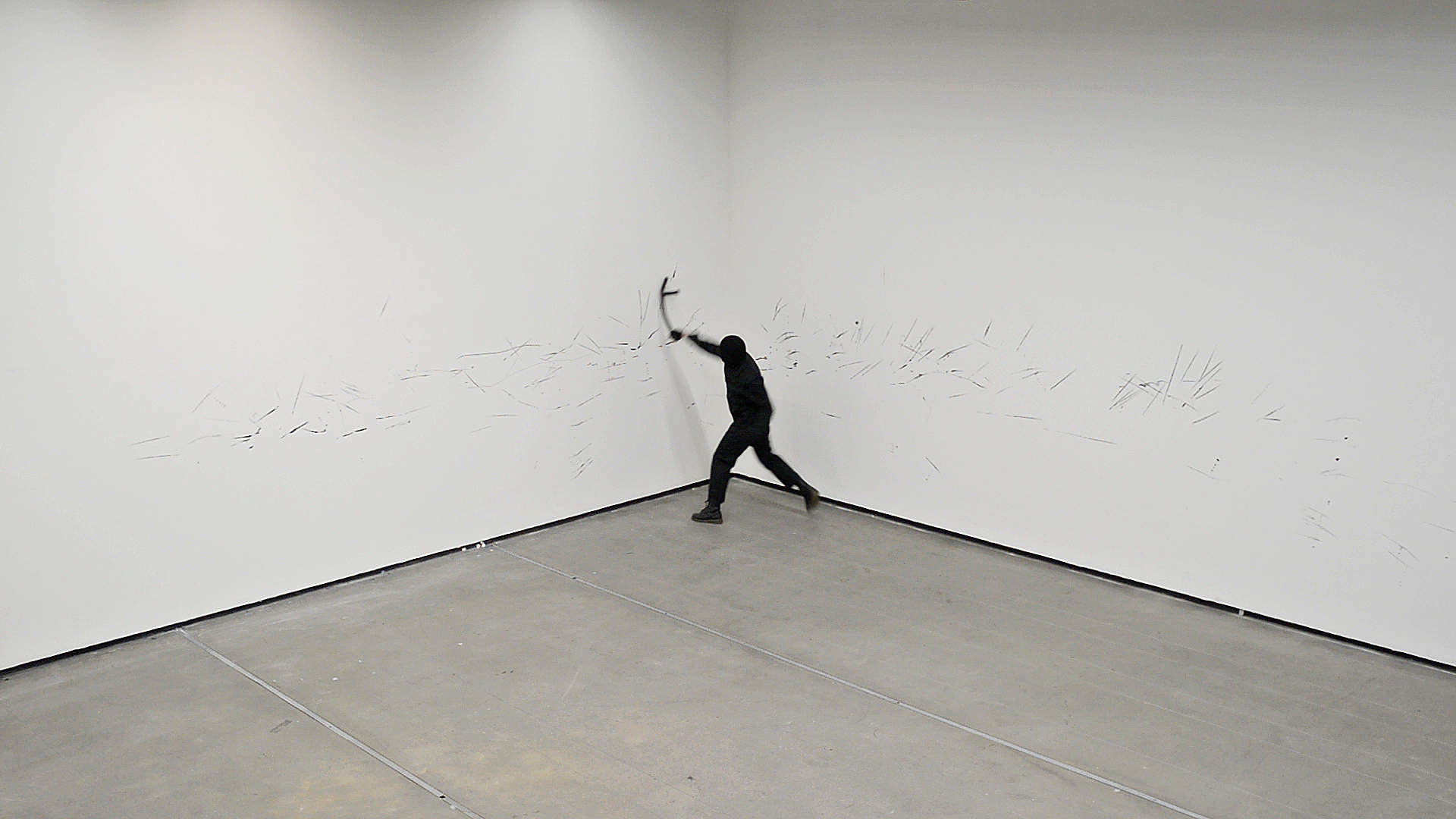Brazilian artist Paul Setúbal embarks on a fearless exploration of the body, crafting a platform for dialogues steeped in conflict and contention. His work, a potent blend of delicacy and power, scrutinizes the body both as a tangible entity, testing its physical boundaries, and as a symbolic domain, navigating the complex dynamics of power relations.
Deeply rooted in research, Setúbal’s practice transcends mere exploration, becoming a multifaceted journey through the complexities of the body in contemporary society. Utilizing diverse mediums – including sculpture, installation, and performance – he breathes vitality and urgency into his vision, ensuring it is seen, felt, and experienced.

All my work starts in the body. When I’m impacted by something, when I’m walking down the street, and I’m faced with a complex situation, when some experience requires hard work to elaborate. Then, my work begins
Paul Setúbal
With an eye for detail and an in-depth fascination with the human form, Setúbal plunges into the intricate problems and symbologies of the body, offering an unfiltered lens through which to view the challenges of control, violence, and power relationships confronting our contemporary existence.
Although his work is entrenched in the socio-political landscapes of Brazil, it stands as a resonant commentary, reflecting and amplifying the harsh social inequalities, historical traumas, and persistent political strife of his homeland. While deeply personal, his works intertwine with broader socio-political discourse, inviting viewers to navigate the complex dynamics of conflict, oppression, and resistance.
Powerfully executed in works such as “Bronze,” a Black Police baton, globally recognized as an object used to exercise force and obedience, Setúbal’s rendition bears the hallmarks of violence, resistance, and control, its frame bent and engraved with the teeth marks of its victims. It stands as a potent reminder of the power this object has over the body in a regime-controlled world.
Setúbal’s work goes beyond mere representation; it is a proactive commentary on the politics of the body and the complex relationships of power that shape it. Throughout his practice, Setúbal invites us to question how our bodies are controlled and regulated and to consider how the tricky ties of power are exerted over us, individually and collectively. In doing so, he offers a nuanced and thought-provoking perspective on these pressing issues, which is both insightful and challenging.
Setúbal lives and works across Brasília, Goiânia, Rio de Janeiro, and São Paulo and holds a PhD in Art and Visual Culture from the Federal University of Goiás has exhibited in various institutions within Brazil and internationally. This October, as part of the Marina Abramović Institute’s (MAI) takeover of Southbank, Setúbal will perform “Because the knees bend.” In anticipation, we delved deeper into his practice, sources of inspiration, and more, uncovering the layers and depths of his compelling work.
Hi Paul, How are you doing? Thank you for taking the time to speak with us. Please tell us a little about yourself, your background, your journey as an artist, and what ignited your passion for art.
Paul Setúbal: Thank you for the invitation. It’s always good to talk about the work process. I currently live and work between Brazil and Spain, and this transit condition has always been present in my work and life. Every artwork I do is part of an experience that somehow impacted me or it literally moved my body. And this way of producing goes back to my background, as I was born in the interior of Brazil, in the State of Goiás – a rural and working-class context of incessant territorial struggles and all the issues that the idea of modernization and the exploration “in the name of progress” can bring to a country. I lived in Brasília, a young federal capital built-in “deep Brazil” near the city in which I was born, Aparecida de Goiânia. Here, I lived in a context that reflects the political issues of a country deeply marked by the wounds of its colonial past.
I lived between Brasília and Goiás for most of my life and then lived for some time in Rio de Janeiro, but now I am currently between São Paulo and Málaga. In this constant transit, in this diversity of social experiences and their dichotomies, my work emerges as a dialogue between body, territory, society and its limits. And in this way, living in transit, my work is increasingly dedicated to dealing with how local questions are also global questions in a more connected and interactive world configuration. In my experience, the path of art has always been a place where I could work with a diverse range of questions, always respecting their complexity and ambiguity – just as life does not carry absolute answers.

Photo by Paul Setúbal
Your practice delves deep into diverse mediums such as sculpture, installation, drawing, painting, video, photography, and performance. At its core, you explore the intricate nuances and symbolisms of the human body in today’s society, looking at use, control, violence, resistance, abuse, and power relationships. Could you shed light on what drives your practice and where your inspiration stems from?
Paul Setúbal: All my work starts in the body. When I’m impacted by something, when I’m walking down the street, and I’m faced with a complex situation, when some experience requires hard work to elaborate. Then, my work begins. And it’s the development of the work that tells me which media I’m going to work with.
Sometimes, I start with a drawing, and the work turns into a video. Sometimes, I start with a sculpture, and the work turns into a performance.
I often produce different works in different media with the same title because they start from the same experience. But in all my work, regardless of the medium, you can see the body as a theme, as a means or the presence of the body’s action in the work: the intensity of the brushstroke, the mark of the body engraved in the bronze sculptures, the body tested to its limits in a performance.

Photo Paul Setúbal
What initially prompted you to position the body as a pivotal element in your work? In your view, how does our relationship with our bodies shape our perceptions of conflict and power dynamics?
Paul Setúbal: I believe that the body, our “support” on earth, is both an extremely fragile unit and one with an incredible capacity to withstand all kinds of pressure from society, whether physical or emotional. When I say that my work begins first in the body, I mean that the body acts as a great sensory receiver through which it collects an infinite amount of information, but that the elaboration of this information requires work, be it mental, physical, spiritual, etc. Something that interests me in many of my works is to take back, with the work, some of this first, somewhat raw information from some situation that generated the work and that carries a lot of complexity, ambiguity and doubt.
However, in the work, I want to bring back some trace of that first sensation, presented as a process of transformation, always remembering that transforming is not the same as solving or finalizing something, but rather that a work of art is a process that shows the transformation of things, whether to broaden their field of discourse or to broaden their field of sensitivity. For this reason, it is often capable of providing a transformative experience.
Working across such a broad spectrum of media must offer unique insights. How has this multi-faceted approach influenced or honed your views on the body?
Paul Setúbal: Each work will require a different medium because the media have their own particularities, history and provoke different sensations – in the same way that the construction of a work is also a kind of reconstruction of some experience that the body has gone through. The materials themselves contain many sensory layers that I explore in my work, always attentive to the type of experience that each material can provide.
In this sense, the various media become fundamental in the creative process, as a possibility of subverting or amplifying the sensation in the body of those who encounter the work. In this way, I construct a series of operations that are only possible in the field of art. For example, where the body becomes stronger than metal, capable of engraving it, or where the body is capable of imposing a force that can bend steel, or even where the body is capable of transforming energies such as violence into an experience of resistance.

Photo Paul Setúbal
Your work addresses intense themes like violence, resistance, and abuse. How do you approach these subjects with the right depth and sensitivity, ensuring they’re treated with the gravitas they deserve?
Paul Setúbal: When I create my work, it is always based on a personal experience. I am aware that the viewers may share some part of my experience, either through contact with the work or because they have been through something similar. Therefore, I first talk about my subjectivity, knowing that human beings share similar life problems. I deal first with the impact on my body, with the care, respect, and calm necessary for the process of creation that makes the work to reveal itself as a transformation. That’s why one of the most important elements in my production is the ambiguity evoked by the work.
When I maintain ambiguity, I also maintain many dilemmas and unanswered questions that are intricate to the themes of the works. And it is in the difficulty and fragility as a human that my work resides, because I am the one who first went through some adverse situation before producing the work. The transformation in my work is not romantic or messianic, like a pretension of resolutions, but a transformation according to a human condition, where resisting, enduring and facing difficulties is in itself a movement of transformation, without the need for a happy ending.

Bronze and aço/steel.
Platform: 250 x 160 x 40 cm. Parede/ Wall: 550 x 210 cm.
Photo by Paul Setúbal.
Treading the line between representing the body in conflict and not commodifying or sensationalizing trauma can be challenging. How do you maintain this balance in your work?
Paul Setúbal: I believe in the transformation of energies. Trauma itself, whether in popular understanding or for psychoanalysis, is not a theme in my work. At times, a traumatic event has been the driving force behind some of my work. The spectacularization of trauma doesn’t interest me either, but rather the possibility of transformation that the body possesses and that we can only access a portion of this capacity.
Nor do I believe in transformation in a messianic, commodifying or sensationalizing sense, because the uncertainties and ambiguities of life make me believe that art has the power to broaden a discussion and not simply resolve it. Life is hard for all of us. Death was always present in my daily life during my childhood. So, I often appropriate this harshness, or the symbols of power, in order to re-signify them.
The attempt to destroy the “trauma” as a solution to the trauma in my experience only fed its permanence. That’s why I believe that any possibility of transformation requires a lot of work, a lot of energy, and as hard as it is, it often means dealing with our fragility, often in a fragile way. Even those energies that are so hard for us can be “bent”, channelled and used as a driving force for transformation. Much of my work is a kind of exercise in which the body is not only capable of resisting adversity, but also of transforming adversity into motor energy. Art is a condition of perennial struggle where it is often necessary to implode the “harshness of life” as a form of re-signification.

Photo Paul Setúbal
Our society has layered complexities when it comes to its control over individual bodies, touching aspects of gender, race, and class. How do you weave through these layers and intersections in your art?
Paul Setúbal: I come from a working-class background, from a miscegenated family in one of the most unequal states in Brazil. My work is a look at my daily life, my life experiences. It’s impossible to make a work without first addressing my family constitution, in a peripheral and extremely violent context. Above all, these are issues that are part of my constitution as an individual who throughout his life has sought to give new meaning to his personal experience and who finds in art a space to discuss these issues.
Another point is how my family’s migration story is also a story that deals with territorial issues. In addition to the family constitution of a colonial miscegenation, I come from a family that found itself in the Brazilian Midwest for the construction of the federal capital, Brasília. And as is usual with spaces of power, which need so much labour for their construction and then disinherit them, I come from a context that reflects in its territory the omission of power to guarantee minimum conditions of survival and dignity for the workers who built it. Part of the issues between territory-body-power in my work is a reflection of this past, so present in Brazil and embodied in its art, architecture, monuments, etc.
So, I am a child of this migratory and miscegenated movement driven by the illusion of the “idea of progress”. It may be that, in some way, my life in transit, my interest in the relationship between body and territory, is also to return to this state of impermanence of my family members, the migratory cycles, the power disputes that seem to be increasingly common problems in all parts of the planet. Here again, one of the points of my production is to investigate how local issues are also global, and vice versa.
This October, the spotlight is on the Marina Abramović Institute at the Southbank Centre’s Queen Elizabeth Hall. As a notable performer, what can attendees expect from this showcase?
Paul Setúbal: It’s a very special moment in my career. In particular, “Because the knees bend” is a work that sums up the points made in this interview very well. The work was initially made in 2018 as a commission for an exhibition that worked with concepts such as absurdity and violence. The work deals with the experience of the body through exposure to violence and how we incorporate and embody its effects. In this way, I evoke this repertoire “incarnated” in my body to generate a performance in which the exhaustion of the body is the rule.
It will be a great challenge to deal for several days with an action that originally started from an explosion until its exhaustion, but which in this version, designed specifically for the space of the Southbank Centre’s Queen Elizabeth Hall, takes on an installation and long durational characteristic. Sometimes the operation of my work is to appropriate certain energies and place them in front of themselves, seeking their “implosion” or transformation.
Like a mathematical calculation, the work deals with an equation where violence, in the same way that we can see socially, is an excess of lost energy because its result is destruction and deconstruction. Hence, in my work the transformation of this energy seeks its implosion, almost metaphorically showing us that violence itself is a release of energy channelled into the construction of nothing.

Photo Paul Setúbal
The societal narrative about the body is ever-evolving. Are there any upcoming themes or dialogues regarding the body that you’re keen to delve into in your future projects?
Paul Setúbal: This Project with MAI comes at a time when I’m looking more closely at projects that deal with the limits of the body on an extended scale, such as long-term projects. For more than ten years, I’ve been working with the limits of the body in projects where the duration of the work is dictated by the nature of the action, be it two, five, ten hours or a minute.
Now, it’s increasingly focused on the resilience of the body, and what happens when it’s put to the test for so long. In the same way, in other media, the work process has been dedicated to processes where the body is not only necessary for construction but its presence can also be noticed. My sculptures have increasingly required a manual process where a lot of energy is required, but in many ways you can recognize this presence in the objects. Perhaps my general interest in future projects is that the works increasingly emanate energy, whether through matter, form or action.
What does the road ahead look like for Paul Setúbal?
Paul Setúbal: I’m on the move between Brazil and Europe, and I’ll be working on projects in these territories for the next few years. It’s a time when I’m dedicating myself to new fields of research that will become solo shows in Brazil and Europe next year. It’s a move that will allow me a constant flow between continents and also continuity in developments that involve international partnerships such as this MAI project. The future is certainly a life in transit in which at each stop I produce and develop another part of my work.
To wrap things up, how would you articulate what art means to you personally?
Paul Setúbal: Art is the only possible path for me. I’ve already tried other ways. All I do is in the path of art. Of the many experiences I’ve had in my life, the idea of art or working with art is the only place where I’ve found interlocution, and I’ll continue to do so. Not as a matter of necessity but as a vital condition. The only way I can fit into the world is through art, otherwise the world isn’t possible.
https://www.instagram.com/paulsetubal/
©2023 Paul Setúbal




